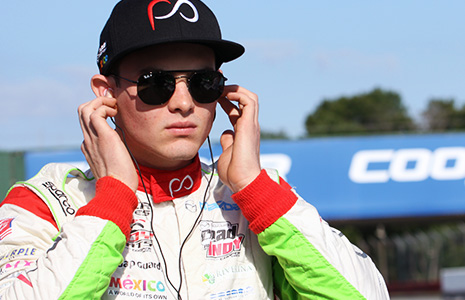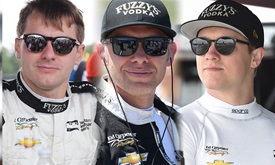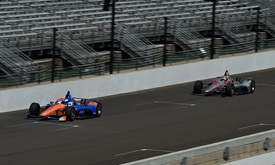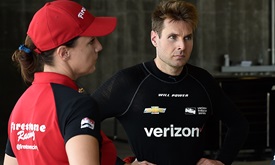Indy Lights field may be shallow, but talent pool is deep
AUG 07, 2018
Let’s say, for the sake of this column, that you’ve got enough coin to start a race team. (Yes, we understand this means you’re hellbent on giving most of that coin away. Just play along with the premise, please.)
Specifically, you’ve zeroed in on starting a team in the Verizon IndyCar Series, and you want to hire young drivers with appropriate skills and the potential to become prominent in the series. Kids who can race competitively without breaking things. Kids who can represent and draw sponsors. Kids who have real racing experience.
Step right up, moneybags. Have we got potential for you.
If you can get past the thin car count in Indy Lights and look solely at the quality of talent, you’ll see what Patricio O’Ward sees. There aren’t many of them, but all are deserving of your attention.
“If you had these seven cars in a 20-car Lights field,” O’Ward says, “all of them would be battling for the top five.”
He’s right. There are only seven full-time drivers in Indy Lights presented by Cooper Tires right now, but all seven are worthy. O’Ward is leading Colton Herta by just 32 points with three races remaining in the 2018 season. Santi Urrutia is third, just 38 points behind Herta, followed by Victor Franzoni, Ryan Norman, Aaron Telitz and Dalton Kellett.
You’d be making a good choice by hiring any of them. If you’ve paid attention to Indy Lights races this year, you’re aware that slight fields often yield abundant talent. If racing had any logical rhyme or reason, two or three of those seven drivers would be locked into Verizon IndyCar Series rides for 2019. Yet we all know there isn’t any logic, rhyme or reason to racing. Their struggle to advance continues, but Lights remains the fundamental and top rung on the Mazda Road to Indy ladder to reaching the goal.
 “Being in Indy Lights and doing well is opening doors,” O’Ward explains. “The hope is that I get to INDYCAR next year. If it happens, it’s because of the experience I’ve had in Indy Lights. If I hadn’t been doing so well, then I wouldn’t have drawn so much attention. They’ve put a good car under me. I’m just trying to take advantage of everything I can and capitalize on every single race that I can.”
“Being in Indy Lights and doing well is opening doors,” O’Ward explains. “The hope is that I get to INDYCAR next year. If it happens, it’s because of the experience I’ve had in Indy Lights. If I hadn’t been doing so well, then I wouldn’t have drawn so much attention. They’ve put a good car under me. I’m just trying to take advantage of everything I can and capitalize on every single race that I can.”
Capitalize he has. O’Ward, one of four Andretti Autosport drivers among the seven full-timers, has won half of the races and eight pole positions this season. Just 19 years old, he’s already assembled a resume that older drivers would envy.
Last year, at age 17, the native of Monterrey, Mexico, became the youngest driver to win a class of the Rolex 24 at Daytona and the 12 Hours of Sebring. In 2016, he won seven races in the Pro Mazda Championship presented by Cooper Tires, the middle level of the MRTI ladder. Last year, after winning at Daytona and Sebring, he helped Performance Tech Motorsports win the Prototype Challenge title in the IMSA WeatherTech SportsCar Championship.
Last week at Portland International Raceway, O’Ward listened in and watched while Herta and Zach Veach – another Mazda Road to Indy alum – tested Indy cars.
“I was just listening in to see how things operate on a testing day in an Indy car,” O’Ward said. “But honestly, it’s almost the same as if I was testing a Lights car. There are a lot more things you can move and adjust in an Indy car. It’s a little bit more to take in, but the general aspect of it is pretty straightforward.”
Since the Mazda Road to Indy was formed in 2010, bringing together Indy Lights, Pro Mazda and the Cooper Tires USF2000 Championship powered by Mazda in a defined ladder system under a single umbrella, the results have been positive. The Indianapolis 500 in May featured 10 former Lights champions, five winners of the Freedom 100 (the marquee Indy Lights race on the same Indy oval) and 24 drivers with MRTI races in their past.
Reigning Verizon IndyCar Series champion Josef Newgarden will tell you – and he has, loudly and often – that his 2011 Indy Lights championship was essential to his advancement. James Hinchcliffe, who finished second in the Lights championship in 2010, would say the same. The reason Ed Carpenter came to be so fast so quickly at Indianapolis Motor Speedway was due in part to his Freedom 100 win in 2003.
The skills of Helio Castroneves and Tony Kanaan emerged during their championship duel as teammates in Lights in 1997. Consistency was Oriol Servia’s modus operandi when he won the Lights title in 1999. And Scott Dixon wouldn’t be the Iceman without a pre-chill championship in Lights in 2000.
So, future team owner with money to burn, about that talent you’re looking to hire? It’s difficult to miss. It’s right in front of you.



















